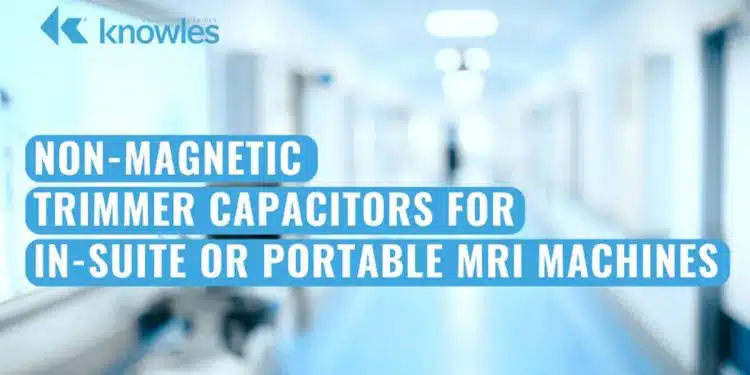This article based on Knowles Precision Devices blog provides overview of magnetic resonance imaging (MRI) systems and their needs for non-magnetic components such as trimmers or MLCC ceramic capacitors.
MRI systems are so robust and require so much infrastructure that they need their own dedicated room—until recently.
A portable magnetic resonance imaging (MRI) system, or point of care (POC) MRI machine, is a compact, traveling device that’s designed for patient imaging outside of the traditional MRI suite (e.g., emergency rooms, ambulances, rural clinics, field hospitals, etc.)
To best perform in these settings, POC MRI machines are subject to strict size and weight constraints. Like traditional MRI systems, POC MRIs leverage powerful magnets, but here, they’re much smaller. For example, most MRI systems rely on magnets ranging from 1.5T to 3T. In contrast, Hyperfine’s new POC MRI machine features a 0.064T magnet.
While many specifications change when MRI machines are designed for portability, these devices are still expected to provide accurate, clear images in a safe manner. Designing for reliability remains a central objective, and it starts with the smallest components in the system.
Non-Magnetic Trimmers and MLCCs for POC MRI Machines
Non-magnetic capacitors, particularly trimmer capacitors, are essential in POC MRI machines because they accommodate precise control of the radio frequency (RF) coil’s resonant frequency and impedance, which determines the machine’s sensitivity to RF pulses and signals. In the low noise amplifier (LNA), an essential component in the receiver chain, capacitors are responsible for ensuring optimal performance and enhancing signal quality, and by extension, image quality.
Knowles Precision Devices offers an extensive line of non-magnetic components for MRI applications, including:
Non-Magnetic Trimmer Capacitors
Many of our trimmers are available in a non-magnetic format. Using the same closely controlled material designations as our magnetic hardware, these components exhibit no measurable magnetism.
High Q Non-Magnetic Capacitors
For minimal power loss and low self-heating, Knowles Precision Devices offers a range of ultra-low loss High Q ceramic capacitors with C0G/NP0 characteristics. These capacitors are uniquely suited for MRI body coils and are available with copper electrode BME materials if needed.
All Non-Magnetic SMD Capacitors
Our MLCC capacitors with silver/palladium (Ag/Pd) or copper terminations are designed for magnetically sensitive environments where traditional solutions with magnetic properties (e.g., nickel barrier terminations) won’t suffice.
Design Guidance
Knowles Precision Devices is a trusted source for non-magnetic trimmer capacitors and MLCCs. As MRI system design changes and the engineering challenges evolve, we’re here to help you select the right components to bring your ideas to life—big or small. See Trimmer Capacitor Considerations in Practice for more information on component-specific design considerations.

































